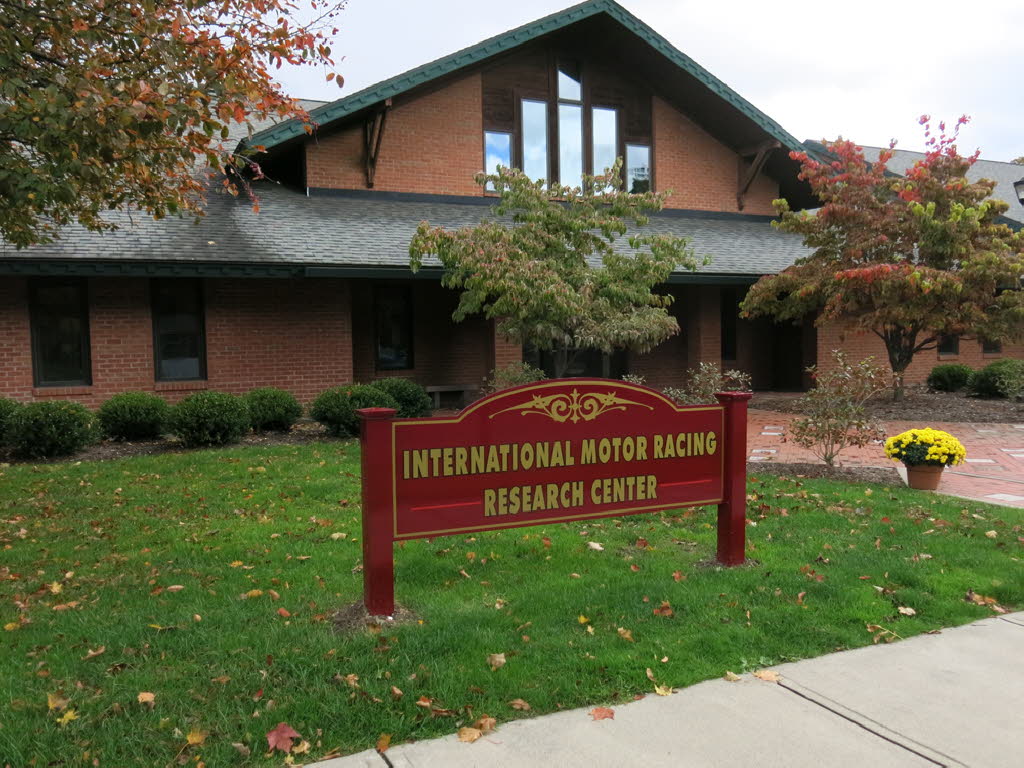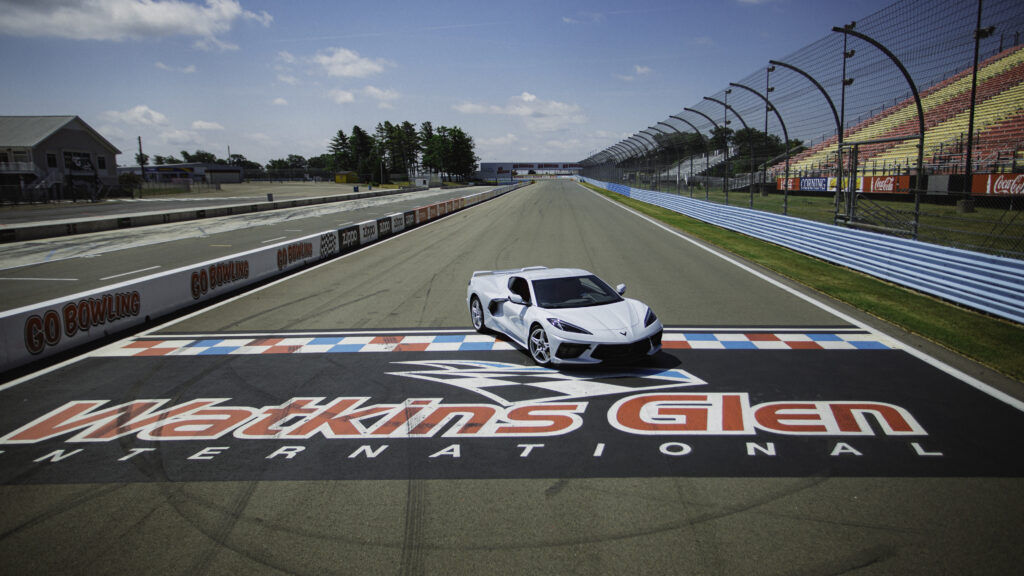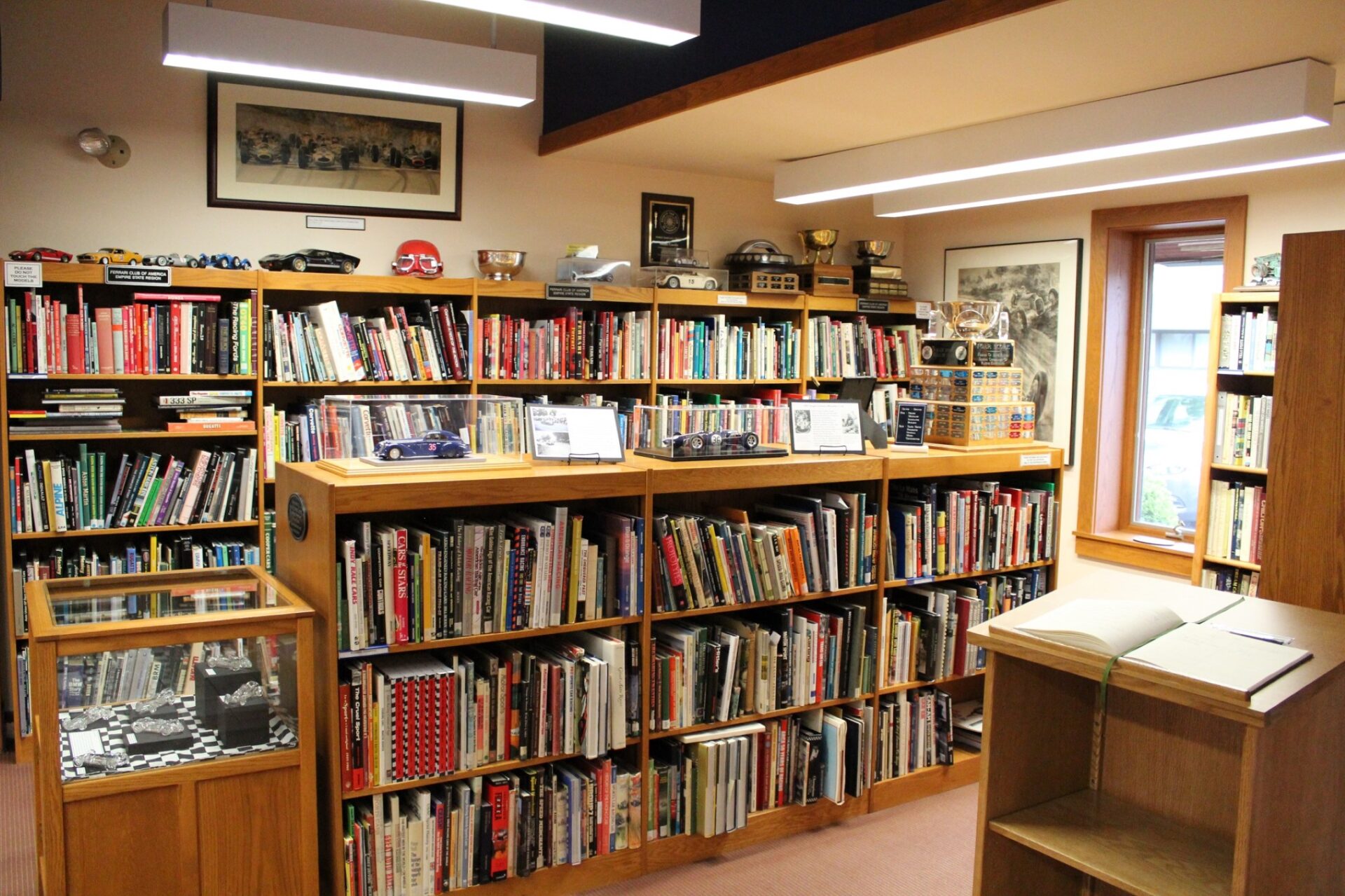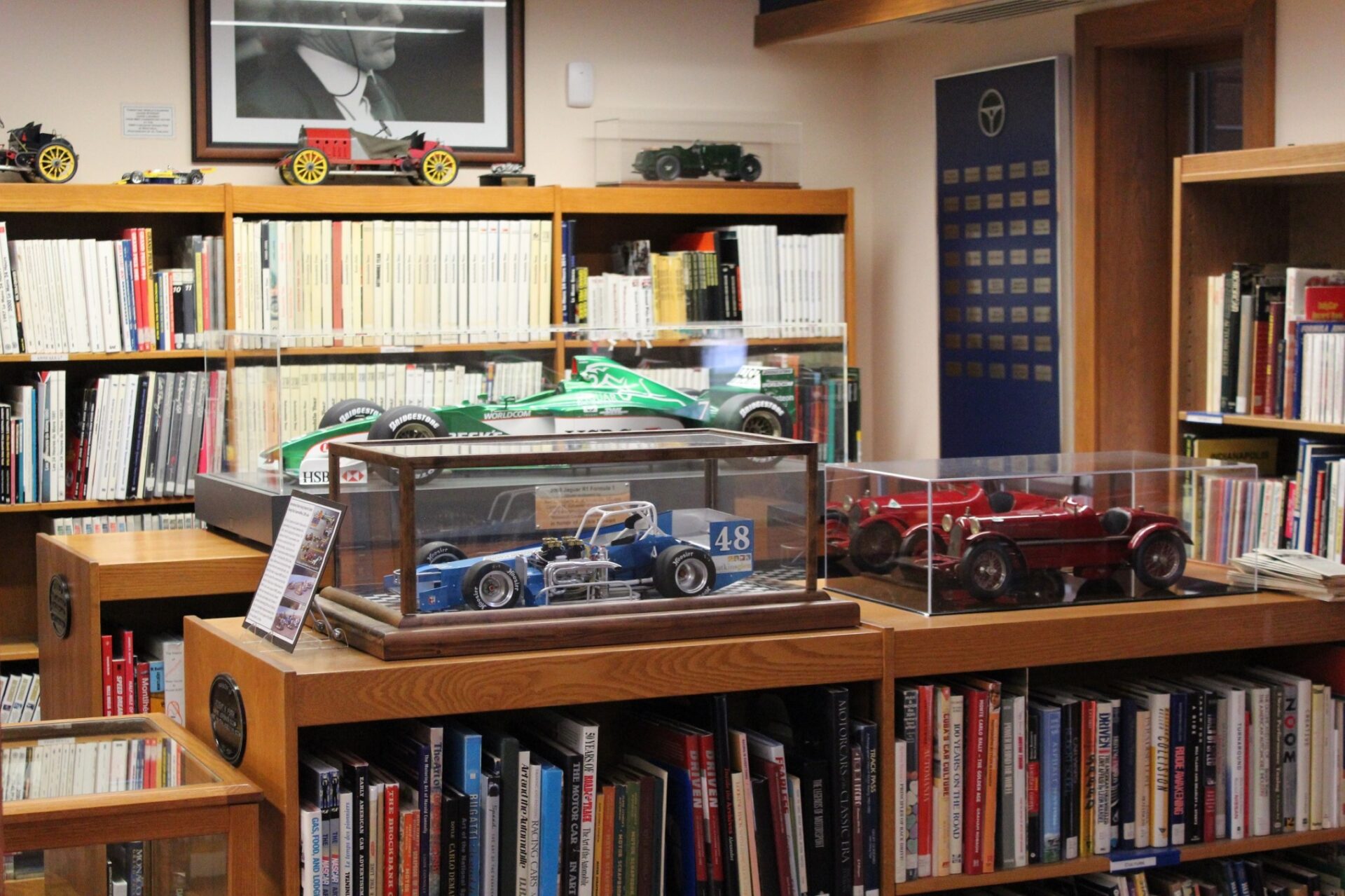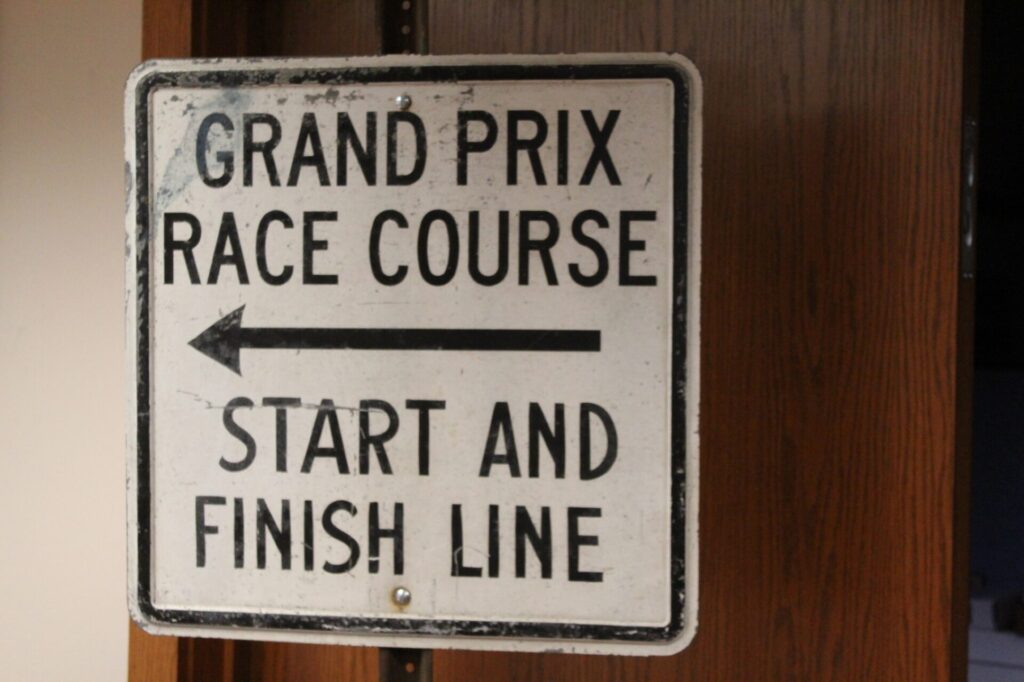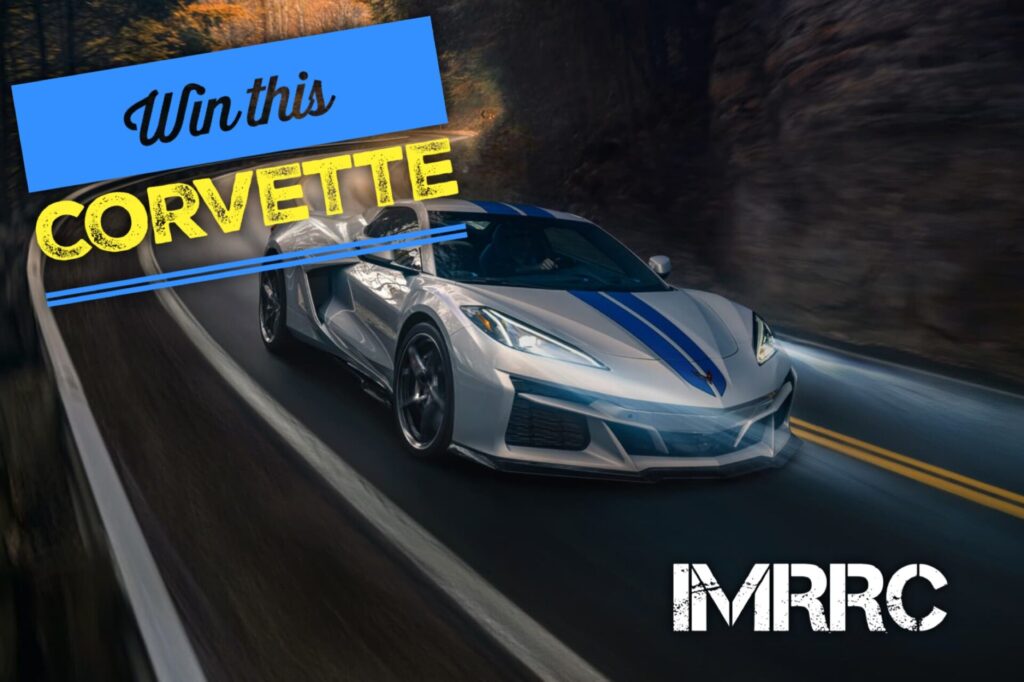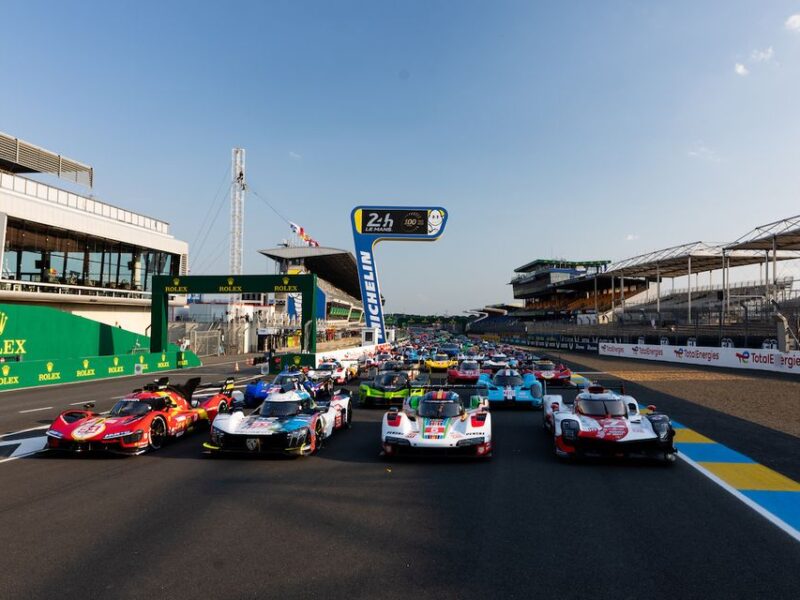The International Motor Racing Research Center (IMRRC) collects, shares and preserves the history of motorsports. Spanning continents, eras, and race series, the Watkins Glen based IMRRC’s collection embodies the speed, drama and camaraderie of amateur and professional motor racing throughout the world. For 25 years, the Center has welcomed serious researchers and the casual fans alike to share stories of race drivers, race series, and race cars captured on their shelves and walls.
We were very fortunate to speak with the IMRRC during our first Season of Break/Fix where Kip and Rick shared all sorts of stories about the Glen and we’ve been working with them closely over the last 3 years. But this time we want to welcome IMRRC director Mark Steigerwald to celebrate the center’s 25th Anniversary with us.
Notes
- Let’s introduce the listeners out there to Mark, the petrol-head. Tell us about your automotive and motorsports enthusiast past. How did you get involved in all this?
- The effect of COVID on the center – let’s remind people of what was, and what’s coming back: Center Conversations? Relationship with the SAH? The “new and improved” symposium
- This is a big year for motorsports too, 100th Anniversary of LeMans – thoughts?
- What does the next 25 years look like for the center? Future plans, anything you can share? Teasers for Symposium ‘23?
and much, much more!
Transcript
[00:00:00] Hello and welcome to the Grand Touring Motor Sports Podcast Break Fix, where we’re always fixing the break into something motor sports.
The International Motor Racing Research Center or I M R R C for short collects shares and preserves the history of motorsports spanning continents, eras, and race series. The Watkins Glen based Im RRCs Collection, embodies the speed drama and camaraderie of amateur as well as professional motor racing throughout the.
For 25 years, the Center has welcomed serious researchers and the casual fans alike to share stories of race drivers race series, and race cars captured on their shelves and walls. We were very fortunate to speak with the I M R R C during our first season of Brake Fix, where Kip and Rick shared all sorts of stories about the Glen, and we’ve been working with them closely over the last three years.
But this time we wanna welcome. Im Rrc Director Mark [00:01:00] Steigerwald to celebrate the center. 25th anniversary with us. So welcome to the show, mark. Thanks, Eric. Glad to be here. So before we dive into the center on a whole new level in the last 25 years, retrospective and what’s coming, let’s introduce our listeners to you, mark the Petrolhead.
Tell us about your automotive and Motorsports enthusiast past. How did you get involved in all this? Well, I guess it depends on how far I want to go. Back. When I was in graduate school at Syracuse University, I was pursuing a master’s in library in information Science, and it was sort of a interesting period.
It was a late nineties, uh, technology was really booming. All of my colleagues, my professors encouraged me to get into, uh, some sort of, Area such as, uh oh, corporate libraries or other information science areas. And I needed an internship and I was at the track, like any true motorsport enthusiast that was within driving distance of Watkinson International.
And I heard over the PA system that a library was opening and Watkinson, and I thought, well, how fortuitous I have to investigate that. So I knocked on the [00:02:00] door of the public library. I M R C is essentially a wing to the public library in Watkins Klan, and I inquired about an internship, talked to the director at the time, and she said, well, certainly however, we’re just getting set up.
She took me next door and there was a pile of cardboard boxes and what became the director’s office? And an Allard J two on the floor and not much else. Gradually over time, I met the incoming director of the research center. He agreed to take me under his wing. We formed an internship program for me.
Fortunately, I never left . I planned on staying for a three month internship and I stayed for eight years. During that period, we had a lot of challenges, but we had a lot of growth and we had a lot of support from a very interested community. Many of them race fans, but there were also academics that elevated Motorsport history in a way that I had always hoped from the beginning.
Motorsport as a legitimate study for scholarship really made sense to me, and fortunately it wasn’t really a, a hard selling point. 25 years later, we’re still helping [00:03:00] authors with books. We’re helping the curious of all age groups. And just a casual browser as well as the for Richard author, even a few filmmakers out there too.
So it was gratifying work for that initial eight years. During that eight year period, you actually evolved from intern to director at some point. So take us on that journey. How did that happen? Our core. Collection was our library. So a library migrated in a smaller form from the public library, and it, it grew by leaps and bounds.
So we accepted donations of motorsport and general automotive books, and we quickly filled our shelves. So my degree was sort of a, a natural fit. There. Meanwhile, we were starting to acquiree manuscript materials, personal papers, diaries, photo collections, film collections, all sorts of materials that document motorsport that you would expect.
I think what we didn’t expect was a sheer volume of material that came as well as the quality too. So all this material had to be cataloged, had organized, and we had a, a very small staff, a couple of volunteers, and myself as well as the director at the [00:04:00] time. Our services grew as did our complexity and our professionalism.
As I mentioned, always a challenge, but always enjoyable, and we had great community support, both local support as well as the Motorsport community in general. We had built in events around the Motorsport calendar for walking on international, so we would get great influx of people walking through the doors on race weekends.
They always wanted to see what car we had on display or to make a donation or just to catch up. We’ve always had that support since, pretty much since day one. So when did the archival part come into play? How did the partnership with S E C A form? Well, that was after I had initially left. That was a great partnership and a great shot in the arm for the I M R R C, from the standpoint of an endorsement from a sanctioning body.
We are the caretaker of the S E C A archives. Most organizations, even some corporate entities, they don’t necessarily have the resources to manage their own archive. It takes someone special to have an eye and a, and an understanding of how important an archive is to any [00:05:00] organization. And the S E C A Foundation had that connection in mind with us.
It was sort of a natural progress. We have a display case in the center that recognizes S E C A accomplishments. That was perhaps the genesis of that idea. But we’ve always had close relationships with the S E C A, uh, project now that I essentially adopted a year or so ago managed by our head archivist.
Jenny Ambrose is really a fairly large undertaking. We’re certainly up to the challenge. It’s a lot of material, I believe, according to our research assistants. We are up to the letter C in the alphabet going through driver’s files. I believe 40 record boxes just from A to C so far, massive amount of material and a collection that’s actually getting used quite regularly.
I believe about 50% of our research inquiries are centered around that material currently. So it’s gratifying all the way around. And the foundation is, as I said, a great partner in this and a supporter of the program. Absolutely, and we’ve leveraged the center as well ourselves for researching guests on our show, especially for [00:06:00] things like the golden era of sports car racing, where I’ve called up and said, Hey, do you have a profile on so-and-so?
And it’s not necessarily all S E C A material. This was Camel gt, imsa. Depending on what you’re looking for, to your point, if you’re writing a book or putting a movie together, in our case, putting together podcast episodes, interviewing these drivers, it’s a wealth of information. And it came super fast too.
I was surprised by the turnaround time. So I can’t say enough good things. Quality of the material we’re getting back and just the ability to be able to access it. I don’t think you can get it pretty much anywhere else. I’m glad to hear that we hope to leverage this success with other sanctioning bodies in the future.
So yeah. Great success story for us. Continuing with your journey, you hinted a little bit. That you haven’t always been at the center. So you left and then came back. So what did you do and what brought you back? Well, I did make a career change. I was married at the time and I went to work for Cornell University, what is referred to as a frontline fundraiser, raising money, working with alumni.
Really gratifying work. A very interesting, and I think. Even from the beginning, the wheels were [00:07:00] turning in my head that some of the concepts I was learning and appreciating the fundraising front could work for some sort of endeavor such as the I M R R C. I did spend a couple of years briefly at the California Automobile Museum in Sacramento, and that was sort of the litmus test for this.
As everyone says, then Covid hit, so sort of sidelines some plans there. During that period, I did find out about the IRCs seeking a director. Once again, I applied. Gratefully, I was chosen for the position. A lot had changed in over the years. The mission had stayed intact, but the level of professionalism had certainly gone up and I was pleased and proud and, uh, glad to be back.
Initial eight years I was there at the center was a formative period for our collections. A lot of relationships were really established. The fact during that time that are still in place currently. Meanwhile, collections have grown, awareness has grown among the Motorsport community. So we hope to just continue that upward trend.
So you talked about building relationships, there’s a special one. Within the halls of the i m Rrc and [00:08:00] now you’re very close with the Art Sinker family. So do you wanna talk about your relationship with Michael and Duke and the rest? Yes. So back when I had begun, I was, uh, fortunate to meet Gene Azinger, who was one of the key players in the formation of the I M R C.
Gene was a proponent of the public library and the collection as well as racing by virtue of her relationship with her husband Cameron, the founder of Post World War ii, uh, road Racing in America. But libraries were jean’s thing. And Jean, in addition to John Saunders had this idea to knowledge racing’s history.
Uh, this is back in 1998 for the 50th anniversary, in an innovative way, not merely just a museum, but an archive in the library that focused on motorsport. It was through many conversations I had with Jean at the time. She really encouraged me to sort of run wild in a sense with a concept of the I R M R C, apply professionalism, apply whatever cutting edge state of the art procedures were going on in library science at the time, such as digitization, scanning in [00:09:00] photos, and cataloging our books.
Certainly glad to do the work and work with Gene, and then I gradually met most of the Argo singer family, and Cameron also served as our chairman at the time for a short time too. Towards the end of my initial eight years without the Argo Singer family. I think that was a sort of a, a bonding force for me to stay as long as I did.
Michael specifically was essentially our chief marketing officer, great supporter of the center. He also had his day job, but then as he became an author, he was always fortunate to work on his book projects with him, working on images, occasionally editing. It was always enjoyable working with him as well.
What’s really special about the Argos Singer family, and you kind of hinted to it, was talking about the 50th anniversary of Watkins Glen in 1998. They’re one of the founding families of sports car racing in the United States cuz it’s center. Grounded and born there in Watkins Glen. We talked about that on the original episode with Kip and Rich Watkins.
Glen is a special place and the I M R C is just a part of [00:10:00] that whole story, so it’s pretty incredible. Oh no, exactly. A famous family and deceits within Watkins Glen post-war road racing on, on the streets, on public roads. An interim circuit and then the, uh, current circuit location and then the series.
We had NASCAR early on, 57 and 64 and 65, and then again obviously in 88. And then through Current Times and Formula One for a spell, pretty much it’s a who’s who of racing for several decades and that legacy continues. A lot of things changed during Covid and you mentioned that things. Let’s remind people of what was and what’s coming back and how Covid changed the way the center is doing business today and what’s transpired over the last three years since that all took off, attending a lot more Zoom meetings, certainly even at the board level, so that’s not going away anytime soon.
Our board is scattered around the country anyway, the work. Sort of continues. I mean, if you think about research services, we’ve always provided research services essentially worldwide by virtue of our service model. That’s the remote. You know, we, we [00:11:00] did have to shutter some of our programming. Our center of conversations will come back stronger in 23 for certain.
Certainly on the fundraising side, the model changed somewhat. Various government programs. The P p P program that was in place certainly helped us out as well too. And then going forward, I think people are so anxious to do things in person. And then, you know, we’ve gradually, our numbers have gone up since Covid as we’ve opened our doors and we’ve seen a, an influx of people traveling and seeking the center as a destination.
So you mentioned the center conversations. A lot of people that are familiar with the center know exactly what that is, but for those that don’t, what are those about and what do they look like? In 23, the Center conversations were born out of a, a desire to showcase, you know, some of the figures in Motorsport that have been influential over the years, they’ve been local and they’ve been.
National or international. We’ve been fortunate to have some great speakers. We had off the top of my head, I can remember Dr. Fred Simeone, for example. I can remember Lynn St. James, so many others. And then our, our local [00:12:00] drivers, for example. And we focused on several different aspects of racing history. So from the business side, from the driver’s standpoint, from the crew chief standpoint, these are all archived at the center current.
These were always free of charge. Occasionally we had refreshments, for example, and our crowds would vary in size. You were up and close and personal with a a motorsport personality, an intimate way that it’s really encountered, you know, now it’s podcast. But you know, as this series continues, we’re launching a schedule and I believe we’ve got four speakers set up for 20, 23 hours, but we’ll probably backfill with additional speakers as well.
And then there. The symposium, the big one. It’s sort of like put all the conversations together in one three day event. Let’s talk about the symposium. New and improved starting in 22, going forward. What’s the symposium all about? Why should people come out and check it out, and how is it gonna grow next year and beyond?
This is my first go around last November, and as you know, you played an integral part in our success and our. [00:13:00] Last November. So the symposium is a, an international gathering of speakers and participants as well too. Uh, again, free and open to the public on a number of motorsport topics. So this elevates the, uh, center conversations to the true scholarly level.
We had some great subject matter last year, wonderful topics arranged that would appeal to any more sport enthusiast and an opportunity for q and a from an. And this year even live streaming. We hope to continue that again this year. I’m sure we’ll have another great slate of speakers as well as growing our audience.
We have a, a partner in all of this, and that’s the Society of Automotive Historians. Without them, we could not do what we do. The s a H has a. Long and storied history of pulling together similar types, symposia across the country. So we have a great partner in the S a H and now the gtm, we’re doing great as well too.
So again, uh, we’ve elevated our Senate conversations to a scholarly level. And Motorsport deserves it. No end of [00:14:00] topics from 30 zero racing. Any sort of pre-war topic that you can think of all the way up through current e erasing. That’s right. And I’m glad you brought up the S a h. I’m a member of the Society of Automotive Historians myself.
I’ve been working with them, you know, since the symposium. We got some ideas brewing and things like that. And obviously we have our co-branded. Co-sponsored content by both the I M R C and the S A H that we’re replaying through break fix throughout the year. So if you weren’t at the symposium, you didn’t see the YouTube or the Twitch live stream, you can actually catch these as episodes throughout the year continuing into next year.
So, Fantastic stuff and I look forward to, you know, continuing to work with you guys on this because it’s not only the living history, but it’s also the past. There’s a lot of things and subjects and topics that people are interested in, that there’s this wealth of knowledge out there and it’s getting it in front of people.
That’s really, really important. I’m glad you are able to facilitate this through the symposium and the center conversations. Oh, exactly, and we’re we’re able to capitalize on current topics too. I mean, women in motor sports has been fairly common topic in some sense over [00:15:00] the past few years, but I think we’ve just scratched the service of some of the, uh, pioneers, especially pre-war, more and more of these stories.
And these, these women are coming to the forefront. In terms of their exploits. So it, it’s really gratifying to see this level of scholarship applied to, that’s something specifically, since you brought a lot of fundraising techniques back to the I M R C during your hiatus. Let’s talk about the annual raffle.
How does that work? Why is it important? How do you guys select the car that you’re raffling off? Maybe what’s the next pick if you can reveal that little spoiler as a 5 0 1 We essentially raise all of our own operational funding. The core of that is, uh, an annual membership campaign. We’re very fortunate this year we will have Brian Redmond as our sponsorship chair.
We always choose a, a sponsorship chair that helps to sort of spread the message to a group indicating how important it is for our work to continue and how it continues with the supportive. Like them. We have a great campaign at the beginning of the year that helps to launch a, a theme for us throughout the, this year it’s [00:16:00] our anniversary, so, you know, we’re fortunate to have that sort of hook and complimenting our membership is our sweepstakes.
That’s something that began as, as a raffle car. Straight up raffle. A sweepstakes model is slightly different wherein there’s really no. On so-called ticket sales. Uh, we’ve had a ca Corvette for the past two years, quite successful. And this year not quite certain what we’ll have gonna launch shortly.
Again, uh, an important component for our fundraising, and again, ca Corvette’s have been very popular for us and we’ve had other cars in the past. We’ve had vintage Porsches and Ferrari. So, uh, always something interesting that gets our audience’s a. Let’s talk about the 25th anniversary celebration. What have you got in mind?
Is it gonna be a big party? You got something locked down? Well, officially, we will have a party that we’re still pulling the elements together for on September 28th. We’re choosing that date because it’s a Saturday. It’ll be the spiritual anniversary for the very first round three and 1948. For Watkins Glen, that also dovetails with the 75th anniversary of racing into Watkins Glen.
[00:17:00] That’s our somewhat arbitrary date to celebrate, but throughout the year, we will pick other opportunities to promote our own history. We’ve had, uh, several of our fans and supporters come forward congratulating us and 25 years already, so we’re grateful for that and some are being extra generous with their annual membership.
So we, we certainly appreciate. If you’re interested in going to the 25th anniversary celebration of the IM r C, look no further than racing archives.org. All the details should be up on the website shortly, but this is also a big year for motor sports too. I don’t want to eclipse your celebration or the 75th of the Glen, but it is the hundredth anniversary of the first running of Lamonds.
So any thoughts on that mark as a sports car fan, from a personal stand. Lama is an incredibly important event, and certainly from the manufacturer’s standpoint, but it’s world renowned. It’s the race and everyone thinks about it. Was immortalized in a movie starring Steve McQueen? It’s featured in Michael Kaiser’s movie [00:18:00] Speed Merchants.
I’m dating myself somewhat, but then, um, as Lama has evolved, it still has never lost any of its luster. I mean, During the fifties, there was a tragedy, unfortunately that could have really stymied, uh, Motorsport development, but it did not. Lama is the great international road race for certain, so certainly we will, uh, have exhibits and displays at the center celebrating Lama’s history.
Any allegiances, any loyalties that you’d like to share? Do you have a brand that you’re rooting for? I shouldn’t show bias, but I’ve always been a Porsche fan for various reasons. It’s easy to say that, but it depends on where your history comes from. For me personally, it was a experience with a 3 56 Porsche.
My father wasn’t really that mechanically inclined. He worked on his own cars, but the one car he thought he would want to turn a wrench on if he could, would’ve been a 3 56. So that sort of stuck with me. And then, um, I’ve never owned a Porsche. Driven several nine elevens in the 9 28. So the mystique has always been there and it continues to this day for sure.
So thoughts on the 9 63, the new L M B [00:19:00] H prototype. Gorgeous car, technologically advanced. Of course. I certainly would wish Porsche luck . You know, our competition is stiff these days too, and technology evolves ever quicker. So we’re a gorgeous machine, no doubt about it. So since we’re talking about Porsche and you’re a racing fan, what do you think about them potentially allegedly making a jump into Formula One?
I’m glad you asked. I personally would like to see it. Formula One is really enjoying a, a crest of popularity right now. I, for one, don’t wanna see it dissipate in any way. And I think Porsche can really mix up the field. I think it would be terrific. 25. In the bag. What does the next 25 years look like for the center?
Do you have any future plans? Anything you can share? Some teasers maybe. The center is certainly growing by leaps and bounds, probably not unknown, that we’ve always been a little pressed for space. We always have a significant racing car on display. And the library has sort of gradually grown. Anybody who sort of stops in semi-annually over the past few years have seen [00:20:00] that.
But the, uh, collections themselves, film and photo, as well as a periodical collection, which is I believe over 10,000 volumes at this point, continues to grow. So we are in need of additional space. So we’re looking at options, but we have purchased property on Franklin Street with the main street in Blackens Glen at the north end.
Gives us a pretty good f. And we are currently working with an architectural firm around expansion plan. So there’s an awful lot of work that needs to be done beforehand that the overall building design that functions that it will contain a lot of work that needs to be done, but we have an opportunity to expand in our anniversary year.
Motorsport deserves it, so we want to take that. Leadership role on like we’ve done with the S E C A and Push Forward. We used to say when we first started 25 years ago or so, for the first few years, so many of our donations were about people cleaning out closets and basements and ats. That still goes on, but as we’ve expanded and as [00:21:00] we’ve honed in on.
Primary resource materials. A lot of that material is out there now, and it’s still somewhat within a, say a, a musty corporate archive. It’s not being utilized. We offer that management option of professionally archiving and making resource material available for researchers could be as simple as a copy of the photo.
It could be more in depth. Since I’ve been back over the past year, I’ve touched base with a couple of authors, but I recall helping 15, 20 years ago that are still at writing authoritative books on motorsport. We’re still helping them with their research. So very gratifying work. It continues, and I can’t personally see and intend to the need for this.
So we do need to expand and we’re, we’re addressing that now. Congratulations. I mean, well deserved and I’m looking forward. The move-in date, you know, to come check it out. Come on tour. So what’s gonna happen to the old I M R C? Is it gonna just be reabsorbed back into the library or will it have a function still?
We’ll continue operations there. Certainly for the foreseeable future, we might repurpose that [00:22:00] space in some way. Certainly it serves us well for office space. We might have quieter space for researchers to work. It’s sort of an evolving project for us, depending on how we’ll continue to utilize that space and what the new space will look.
So Mark, with that, any shout outs, promotions, or anything else you’d like to share that we didn’t cover thus far? Well, I would just encourage everyone to visit. Certainly visit us on the website, but visit us in person as well too. On race weekends, we will expand our hours to being open on Saturdays and race weekends.
In the past, certain race weekends, we might be open the entire weekend, but always call ahead if you’re making plans. But Saturday’s on race, weekends are given in 2020. I’ll certainly thank everyone who’s supported us over the years. There are names too numerous to mention. Uh, I should remind everyone. We have a, a really dedicated governing council made up of leaders in motor sports as well as a local contingent.
Two. Everyone’s invested in the Watkins Glen area. That goes without saying because we’re expanding in Watkins then our operation is staying, uh, rooted right and upstate New York. Our reach [00:23:00] has, has always been international. It continues on that trajectory. Thank everyone who’s, uh, you know, who’s made us the success.
We are these days. We just continue moving forward. Special thanks to Watkinson International. Michael Print up and his crew have always been supportive of us and we’re grateful for his time and our exposure at the track too. I mean, uh, today’s racing will be tomorrow’s history. We’re working hard to preserve all of that history.
Even the most recent racing. To learn more about the International Motor Racing Research Center, check out their website, www.racing archives.org or follow them on social media at IM R R C. And if you happen to be in town Postrace or beforehand, stop by the center and meet up with folks like Mark and KIPP while you’re there.
And if you’d like to get in contact with Mark and be part of the next 25 years of the Center’s growth, reach out to him via email@markracingarchives.org. Mark, I can’t thank you enough for coming on the show and you know, I appreciate the partnership that we’ve grown over the last couple of [00:24:00] years and I look forward to continuing working with the I M R C and being part of the next 25 years and celebrating with you guys this year.
So it’s fantastic. I mean, you guys are second to none. There’s really nothing else out there like this, especially for automotive historians like myself and others that are looking for answers and looking for our haven and our place to go. So thank you. Thank you for everything you guys. Oh, thanks Eric.
We really appreciate the opportunity and uh, yep. Come in and see us when you. The following episode is brought to you in part by the International Motor Racing Research Center, as well as the Society of Automotive Historians, the Watkins Glen Area Chamber of Commerce, and the Azinger family.
If you like what you’ve heard and want to learn more about gtm, be sure to check us out on www.gt motorsports.org. You can also find us on Instagram at Grand Tour Motorsports. Also, if you want to get involved or have suggestions for future shows, you can call our text at (202) [00:25:00] 630-1770 or send us an email at crew chief gt motorsports.org.
We’d love to hear. Hey everybody, crew Chief Eric here. We really hope you enjoyed this episode of Break Fix, and we wanted to remind you that G T M remains a no annual fees organization, and our goal is to continue to bring you quality episodes like this one at no charge. As a loyal listener, please consider subscribing to our Patreon for bonus and behind the scenes content, extra goodies and GTM swag.
For as little as $2 and 50 cents a month, you can keep our developers, writers, editors, casters, and other volunteers fed on their strict diet of Fig Newton’s, gummy bears, and monster. Consider signing up for Patreon today at www.patreon.com/gt motorsports. And remember, without fans, supporters, and members like you, none of this would be possible.[00:26:00]
To learn more about the IMRRC check out their website www.racingarchives.org or follow them on social @imrrc – and if you happen to be in town, stop by the center and meet up with folks like Mark and Kip while you’re there. If you’d like to get in contact with Mark and be part of the next 25 years of the center reach out to him via email mark@racingarchives.org
Watkins Glen… just saying the name conjures up stories of legend.
“The Glen” is a town built around motorsports, and more importantly, its famed racetrack is the one that kicked off sportscar racing in the United States. The first iteration of the Watkins Glen International (WGI) Raceway started in 1948 and used the natural terrain surrounding what most people recognize today as “Watkins Glen State Park” along with its waterfalls and giant gorge. Watkins Glen sits at the foot of Lake Seneca (one of the two fingerlakes) in south central New York, not far from places like Corning, Elmira and Ithaca.
Watkins Glen is hallowed ground, home to racing series like: NASCAR, World Challenge (SRO), IMSA, Formula-1 and many others. Visiting landmarks like the bar at the Seneca Lodge, brings back memories of: Mario Andretti, Emerson Fittipaldi, Colin Chapman, Graham Hill, Jack Brabham, Sterling Moss, Jacky Ickx and so many others, it’s awe inspiring to say the least.
Touring the Center
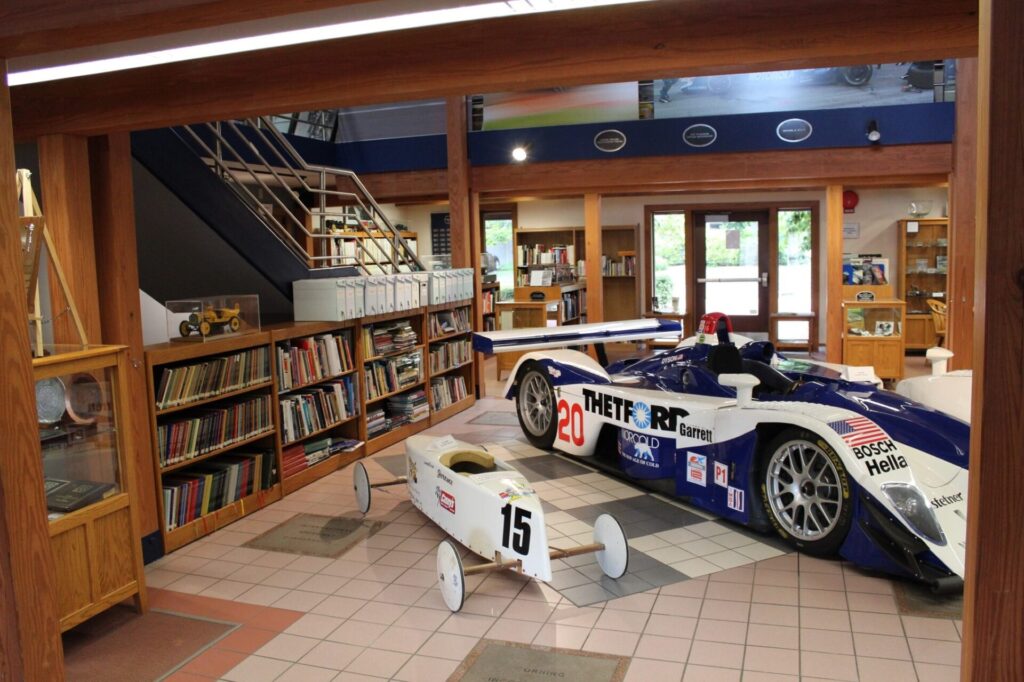
When you walk into the center, you’ll be immediately greeted by some sort of racecar on display. Be it a LMP prototype like this Dyson-MG, or an IndyCar or World of Outlaws Dirt Track racer. Each month, the center has something new on display.
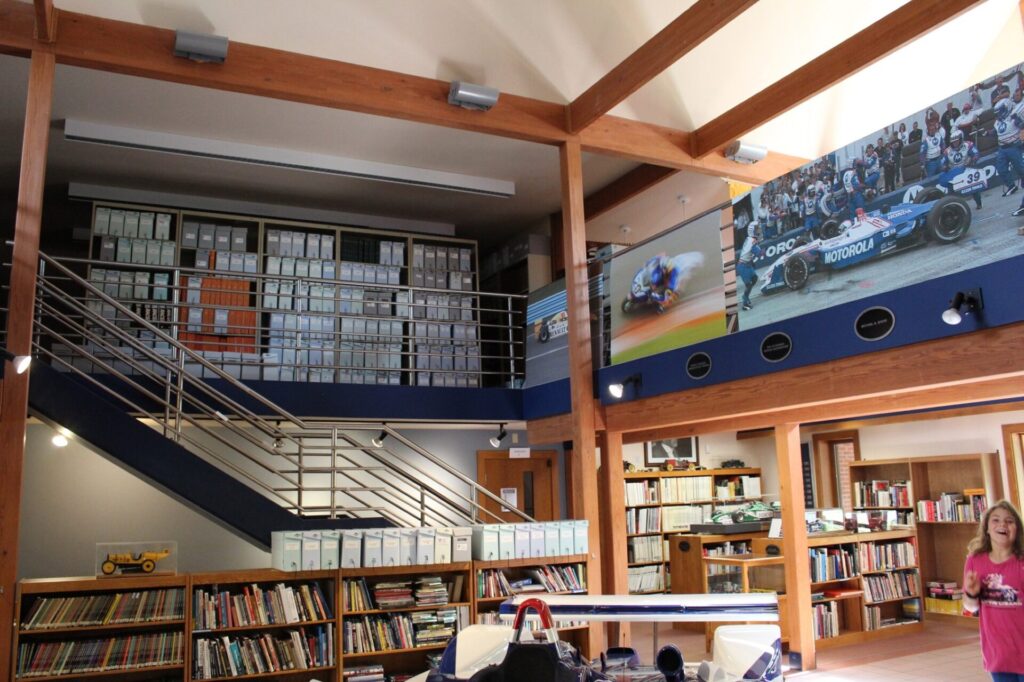
The center is a two story building filled with books, periodicals, programs, memorabilia, and racing results. Much of the SCCA records are kept offsite and can be pulled for review, the amount of information available here can seem overwhelming but it’s all very logically organized and easy to access.
Even though the center’s overall footprint is small, the curators do an excellent job of packing in as many items as they can without making it feeling crowded in any way. Everywhere you turn there is something new to review and explore. Many of the items in the IMRRC have been donated, and there are even specific sections of the library devoted to those organizations, like: The Ferrari Club of America (see picture above).
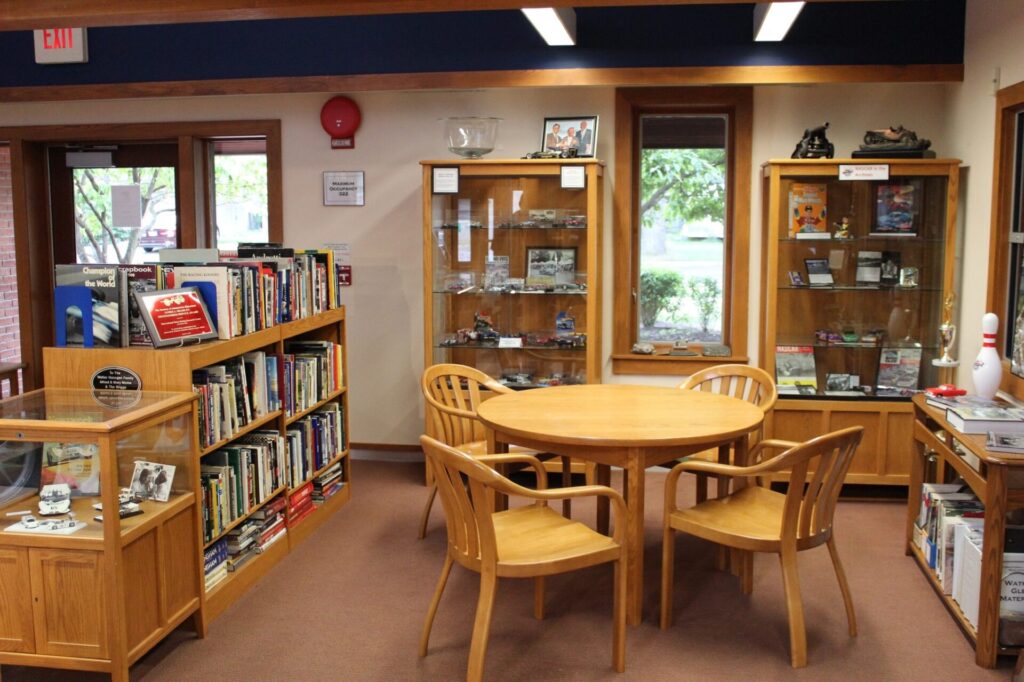
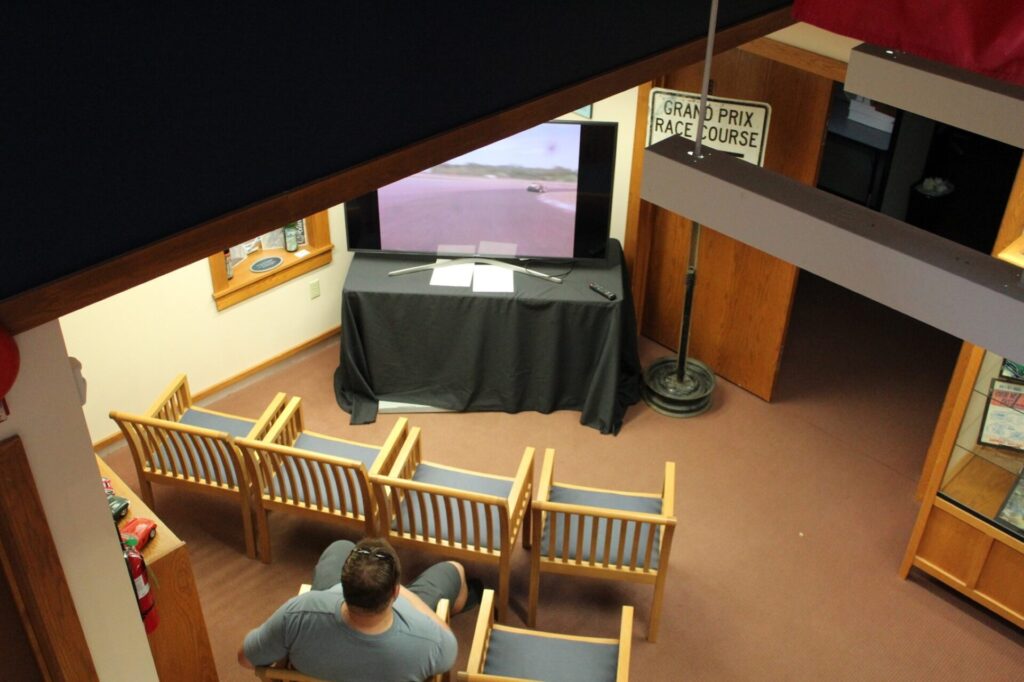
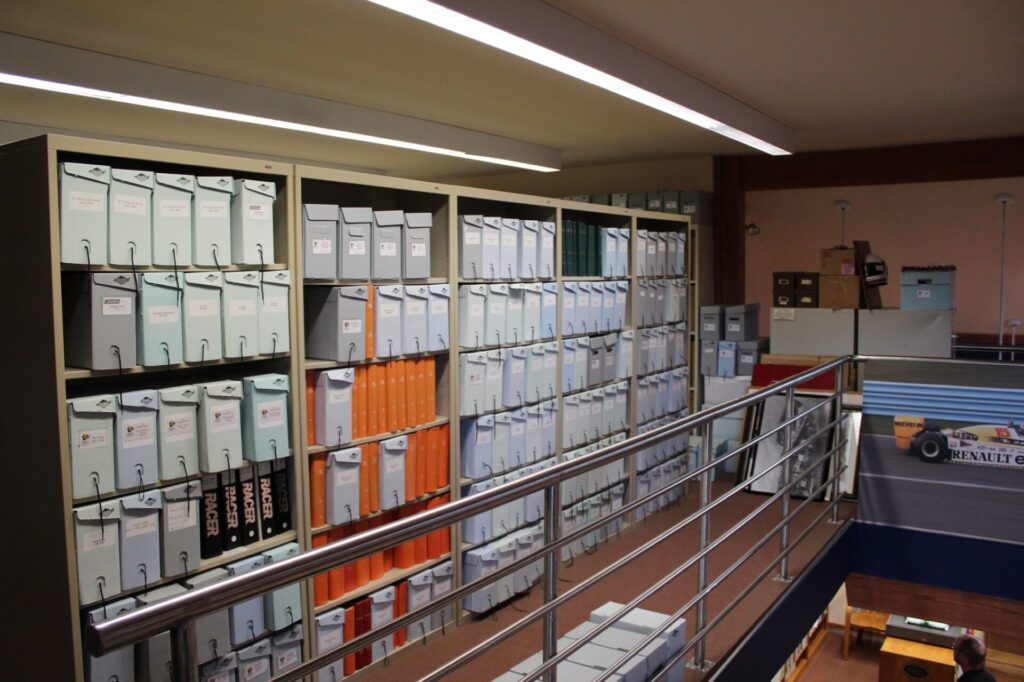
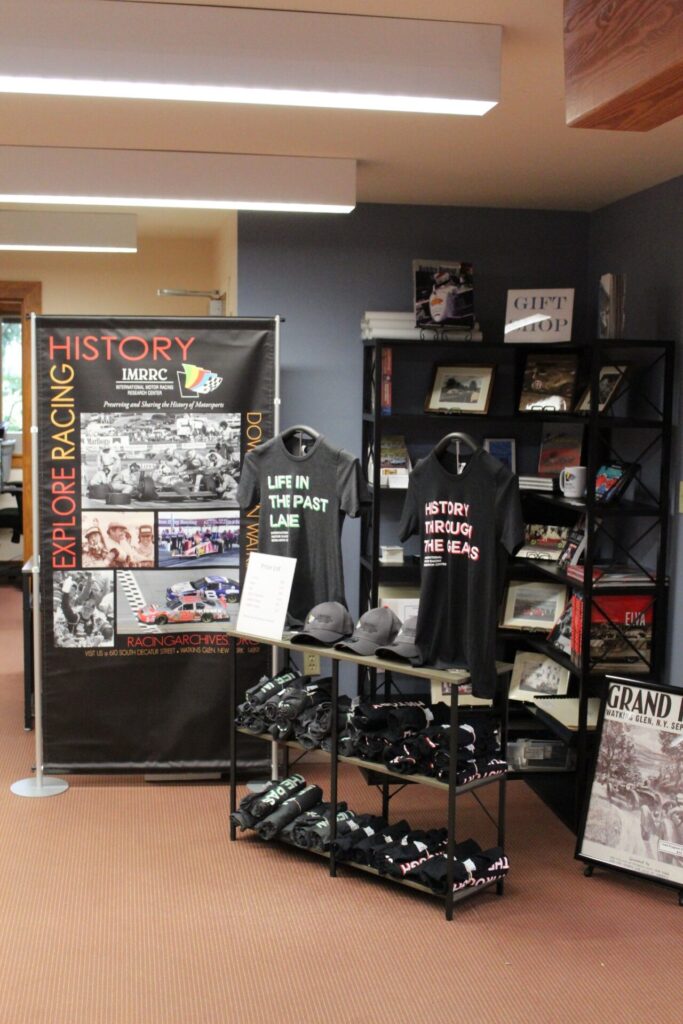
If you’d like to learn more about the IMRRC’s history be sure to check out the Break/Fix podcast episodes below for more details.
Next time you’re on the East Coast, or making the trek to your favorite racing event at Watkins Glen International, be sure to add extra time to your plans and pay the IMRRC a visit. And maybe you’ll see me there doing some research for my next Racers Den article on GSM!
Helping the Center
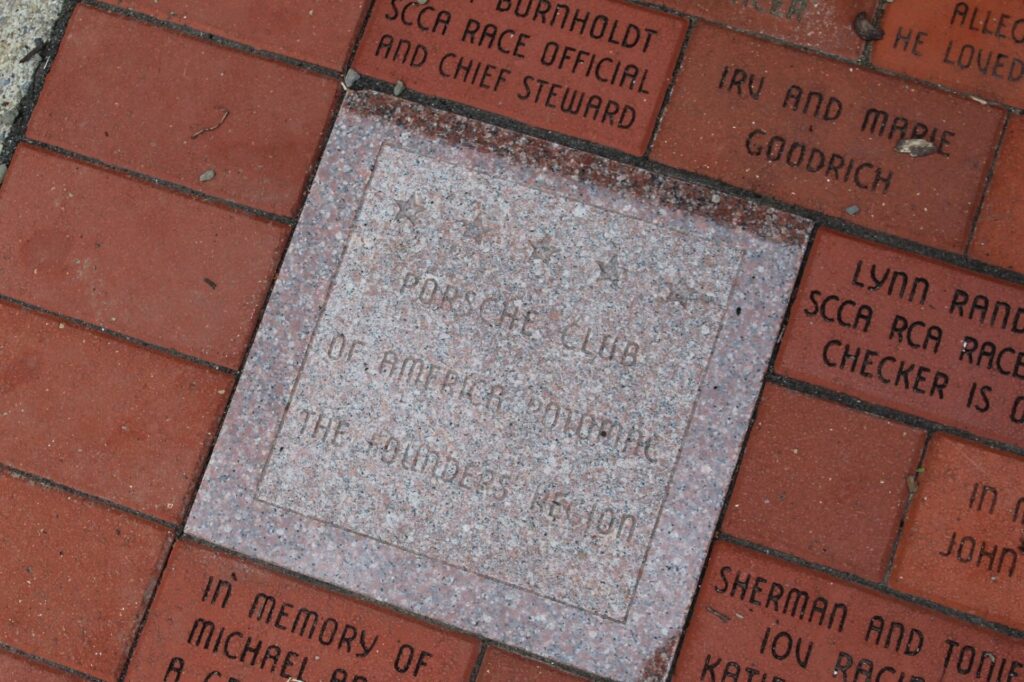
The IMRRC operates largely on donations through physical items, cash contributions and it’s annual sweepstakes. Many of us with large collections, especially consisting of motorsports memorabilia are unsure what to do with those items when we’re moved on from them. The IMRRC is prepared to review them and see if they can be added to the library, or added to their storage. More importantly, the IMRRC raffles off some pretty cool cars each year (or you can take home a $50k payout instead).
This year you have the chance to win a 2024 C8 Corvette E-RAY Launch Edition in silver with blue stripping and matching interior. This car is an absolute stunner! Click here for details on how you can help the center or enter the sweepstakes.
Articles like Celebrating the IMRRC’s 25th Anniversary always appear first on Gran Touring Motorsports.

